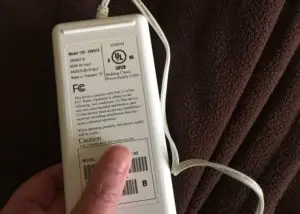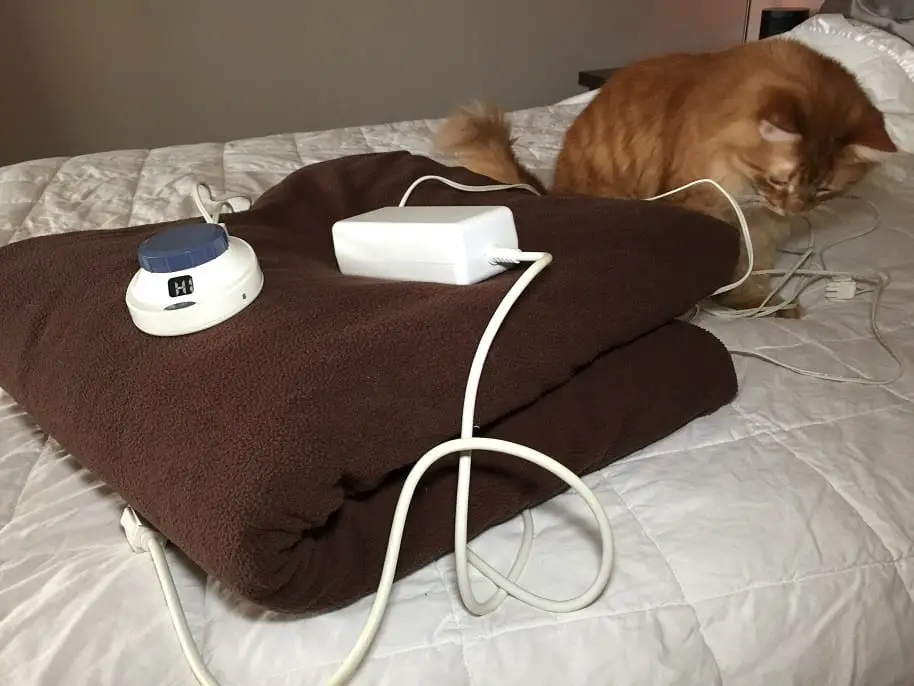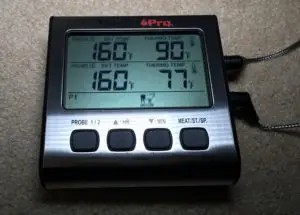Table of Contents
**This page contains affiliate links and I will be compensated if you make a purchase after clicking on my links**
Photo by Alexander Puffer on Unsplash
Layering and safety guidelines for a cozy night’s sleep
Winter is coming, and there’s nothing better than to get into a bed that is already toasty warm. You have your choice between an electric blanket on top of you or an electric mattress pad below you. Or both.
But how do you layer everything?
And more importantly, are there safety concerns with your layering strategy?
All relatively new electric bedding is designed with safety features. If it gets too hot, it will automatically shut off.
However, the safest way to use any electric bedding is to pre-heat, then turn it off when you plan to sleep
The important part here is “relatively new”, as in after 2001.
Purchase an electric blanket new. Don’t buy one at a garage sale or pull one out of a family member’s attic. Not only will you not know the age, but you won’t know what shape the electric wiring is in.
Electric bedding comes in a few different types:
- Electric blanket, intended to be placed on top of you
- Electric under blanket. A rarer item, it’s intended to be placed under you and your fitted sheet
- Electric mattress pad. Like any mattress pad, it may include a layer of padding to protect both the wires and the mattress.
- Electric blanket throw. Smaller than a regular blanket, this item is great to curl up with on the couch in front of the TV.
Does it matter whether the heat is above or below you? Most likely not, as you’ll be cozy either way.
However, one key consideration—and the reason I will never go the “under” route—is that if you get too hot, there isn’t much you can do about it.
But a blanket that’s on top of you can simply be tossed aside if you get too hot.
On the other hand, if you are using the glorious heat for sore back or neck muscles, and you sleep on your back, then having the heat from below is much more direct.
[Phone viewers: turn your phone sideways for easier viewing.]
| Electric Blanket | Electric Under Blanket or Mattress Pad |
|---|---|
| PROS – Save on heating bill by keeping home cooler at night – Gentle heat may be good for sore muscles, arthritis, etc. – If you get too hot you may simply throw the blanket off | PROS – Save on heating bill by keeping home cooler at night – Gentle heat may be good for sore muscles, arthritis, etc. – Direct therapeutic heat for back sleepers – Stays in place; good for those who sleep with blanket stealers |
| CONS – Can be tossed aside by those who toss and turn; subject to blanket stealing – Safety concerns (see below) | CONS – If you get too hot, you’re stuck – May feel the wires under you – Safety concerns (see below) |
What is a low voltage electric blanket?
A traditional electric blanket or mattress pad simply plugs into the wall and delivers ~120 volts (US) into the wires within the blanket.
More recently, because of safety concerns, you may purchase an electric blanket that uses low voltage. You can immediately tell if yours is one because there will be a transformer box located between the wall and the blanket.


This small box reduces the voltage. In my blanket, it reduces 120 volts to 24 volts.
If there is a broken wire, you are less likely to electrocute yourself or start a fire.
Likewise, the lower voltage should produce weaker electromagnetic fields (EMFs) and reduce potential cancer risk (see below).
Another advantage is that the wires can be smaller, so if the feel of wires bothers you, consider a low voltage blanket.
Want to learn more about my low-voltage electric blanket (pictured above)? Check out the Buyer’s Guide on heated bedding.
Do low voltage electric blankets get as hot?
It’s been my experience that my low voltage electric blanket warms slower and doesn’t get as hot as a regular electric blanket. But that could be specific to my model.
This temperature limitation is an added safety feature that prevents you from overheating.
Mini-experiment

I did my own mini-experiment comparing my low voltage electric blanket (brown) to my favorite electric throw (grey). Both items are relatively new, purchased within the last seven years or so.

I used a dual-probe cooking thermometer to measure the temperature on the highest setting. Note, the low voltage blanket (bottom right) maxed out at around 77 º F, while the throw maxed out higher at over 90 º F (top right).
Note that Andy also prefers the hotter blanket. (And yes, measurements were recorded after he left. They were much higher with him sitting there.)
If you have a regular voltage electric blanket, don’t toss it just yet
With a regular electric blanket, it is unlikely that you will electrocute yourself. However, if you have pets that enjoy chewing wires, then one thing to consider is Ground Fault Circuit Interrupter (GFCI).
Assuming your home is up to code, GFCI outlets are standard in the bathroom, kitchen, and outdoors. Or any area where water and electricity might mix. If you are in danger of electrocuting yourself, these safety outlets immediately shut off.
GFCI outlets are not standard in the bedroom, but you certainly can have an electrician add one. An easier and more cost-effective solution is to simply purchase a short GFCI extension cord.
However, just because you have a GFCI, doesn’t mean you can be careless around electricity. They sometimes fail.
Can you sleep with an electric blanket under you?
Back to the original question.
What if you have an electric blanket but want to test out heat from below before purchasing an electric mattress pad?
Yes, you can place your electric blanket under you.
Should you layer your blanket over or under your current mattress pad?
- With a low voltage electric blanket with thin wires and not as much heat, consider sandwiching it on top of the mattress pad, and directly below your fitted sheet.
- For a regular electric blanket, consider sandwiching it below your mattress pad. The pad will provide extra protection for the wires, and you’re less likely to feel them.
Obviously, if your mattress pad is really thick, you may wish to consider the first option instead.
It’s assumed that your mattress pad is breathable, which should reduce the risk of overheating. Note that even waterproof mattress pads that contain breathable polyurethane should be fine.
If, however, you have an older waterproof mattress pad, made with vinyl, I would keep the electric blanket away.
Yes, there is a concern that you may be risking damage to the wires while you toss and turn. Blankets were not designed for bottom use.
However, considering that electric blankets are machine-washable (see below), a washing machine has the potential to do far more wire damage than you ever will.
And you’re only using an electric blanket with a safety shut-off, right?
The risks of using your blanket improperly, in this case, are quite small.
Can you use both an electric blanket and an electric mattress pad?
The internet seems to think this is dangerous.
But if both your blanket and mattress pad have safety auto shut-offs then you’re covered. Pun intended.
To prevent YOU from overheating, the best strategy may be blast both before getting into bed, then turn off the mattress pad after you get into bed.
Turn the blanket to low (or off) to maintain that glorious warmth.
Can you layer bedding on top of an electric blanket?
Absolutely, in fact, you may be able to maintain your blanket on low—or even off—with some extra insulation on top.
Obviously, more blankets may be too warm for you.
If you need multiple blankets, then layer your electric blanket at the bottom, immediately above you and your top sheet. This way you’re closest to the heat.
Alternatively, if you don’t like the feel of the wires, you can sandwich a thin blanket in between you and the electric blanket. However, you may need to pump up the heat accordingly.
For added safety, include a blanket made of wool. Wool is naturally fire retardant.
Can you use an electric blanket with a weighted blanket?
If you are using a weighted blanket on top of you, it’s straightforward to add a heated mattress pad for underneath.
Alternatively, you should still be able to use a heated blanket in combination with a weighted blanket, assuming the latter is stuffed with either glass, silica, or ceramic beads.
I would be wary of using a weighted blanket with other types of weights. Metal beads might conduct heat too efficiently, which could burn the fabric and you.
As with any blanket, you have the choice of placing the electric blanket above or below the weighted blanket.
When it comes to heat, glass is considered a poor conductor, but a good insulator. In other words, if the electric blanket is on top of the weighted blanket it will take longer to pre-heat your bed.
In either configuration, a preheated bed should stay hot once the electric blanket is turned off.
The weight of the weighted blanket may have the added benefit of holding the heat closer to you, which is beneficial to those with muscle pain and arthritis.
For this reason, if your electric blanket is below the weighted blanket, then a lower heat setting may achieve the same degree of heat as you would get without the weighted blanket.
Is electric bedding machine washable?
I’ve always machine-washed my electric blankets without a problem. Ideally, you should stick to the gentle cycle, but I haven’t bothered.
Dry in the drier on low or no heat. Take it out while it’s still damp, and line dry.
If your electric blanket is tough enough to withstand your washing machine, it should be more than tough enough to resist (most) damage from day-to-day use from both you and your pets.
(If your electric blanket is NOT machine washable I would be suspicious as to whether it is tough enough to be safe under general working conditions…)
Like the non-electric variety, mattress pads are usually made of cotton and stuffed with polyester fill. They may also contain polyurethane if they are waterproof. These materials are completely machine washable.
Electric blankets are usually made of polyester fleece, which is also completely machine washable. However, pilling may occur.
Is electric bedding safe?
Nothing in life is truly “safe”.
Everything has “side effects” or risks. We weigh those risks vs the benefits.
Considering the glorious heat electric bedding delivers, especially if you have muscle or joint issues, and the current safety features on new bedding, the risks are minimal.
The benefits should offset the risks, especially if you use common sense precautions.
But you’ll need to decide for yourself.
Here are the possible perils, or bad things that might happen. Also listed is the level of risk, or (low) probability that a bad thing might happen.
On the right are potential solutions to manage or reduce the risk of something bad happening. In other words, the precautions you should follow.
| Possible peril | Risk management |
|---|---|
| Electrocution from faulty wires Risk: very low | – Purchase only new bedding – Inspect for damage before making up your bed – Don’t let pets chew on wires* – Use low voltage bedding – Plug into a GFCI – Don’t sleep with the bedding ON; pre-heat only |
| Fire danger from faulty wires Risk: very low | – Purchase only new bedding, with a timer – Inspect for damage before making up your bed – Don’t let pets chew on wires* – Use low voltage bedding – Include wool bedding – Don’t sleep with the bedding ON; pre-heat only |
| Fire danger from overheating Risk: very low | – Purchase only new bedding with an auto-off feature and timer – Use low voltage bedding – Include wool bedding – Don’t sleep with the bedding ON; pre-heat only |
| Burns from overheating Risk: low / medium | – Purchase only new bedding with an auto-off feature – Don’t use if you have nerve damage and can’t feel heat – Don’t use if you are disabled and can’t easily move if you become too hot – Don’t use on the elderly, babies, or young children – Don’t sleep with the bedding ON; pre-heat only |
| Cancer risk from EMFs Risk: low? | – Use low voltage bedding (risk reduced, but not eliminated) – Don’t sleep with the bedding ON; pre-heat only (risk eliminated) |
| Pregnancy risks from EMFs Risk: unknown | – Don’t sleep with the bedding ON; pre-heat only (risk eliminated) |
*Protect the wires. Don’t use pins, don’t iron your blanket, don’t cut your blanket, etc.
Yes, you can sleep with your electric blanket on (I certainly have), but to be safest pre-heat only, then turn it off before going to sleep.

Does an electric blanket increase your risk of cancer?
Electricity flowing through wires generates electromagnetic fields (EMFs). The strength of these electromagnetic fields decreases rapidly the further away from the wires you are.
All our electric appliances produce low-level EMFs, including our Wifi and cellphones. However, so far, there’s no evidence that typical day-to-day exposure increases our risk of cancer.
Because the wires of an electric blanket or mattress pad are right next to you, possibly for hours at a time, there has been some concern about the EMFs those wires produce.
There have been many observational studies analyzing a large group of people—usually women—and seeing if there is a correlation between electric bedding use and cancer.
The results are… mixed.
- In a 2015 study by Kato, et. al., almost 90,000 women were tracked for over twelve years as part of the Women’s Health Initiative Observational Study. Over half used an electric blanket at some point during that time. No relationship was observed between electric blanket use and thyroid cancer.
- In a 2000 study by Laden, et. al., almost 90,000 women were tracked as part of the Nurses’ Health Study. Although the authors noted some small risks, overall the numbers didn’t support a relationship between electric blanket use and breast cancer.
Unfortunately, not all the data is rosy.
- In a 2007 study by Abel, et. al., more or less the same women from the Women’s Health Initiative Observational Study were analyzed. They found electric blanket users to have a 15% increased risk of endometrial cancer. Women who reported they had used an electric blanket for 20 years or more had a 36% increased risk!
(Just to be clear, this doesn’t mean you have a 36% chance of getting cancer! It means that the tiny risk of getting cancer is now about a third higher. So slightly less tiny.)
This data contradicts an earlier (and much smaller) 2002 study that found no relationship between electric bedding and endometrial cancer.
- In a 2003 study by Zhu, et. al. African American women who used electric blankets and mattress pads, had an increased risk of breast cancer. There was a clear relationship between the cumulative exposure over the years and an increased risk of cancer.
This data also contradicts several earlier studies that showed no increased risk of breast cancer in (mostly Caucasian) women.
As noted by the authors, the long-term exposure to electric bedding in these studies included the use of the older EMF-heavy models. It’s not known if today’s newer blankets are safer—especially the low-voltage versions.
Likewise, all these studies are observational. Just because electric blanket use is correlated with an increased risk of cancer, doesn’t necessarily mean electric blankets caused the issue. (“Correlation is not causation.”)
There could be another thing that correlates with electric blanket use that could be the real culprit —perhaps something associated with cold weather, like home heating, diet, exercise, etc.
Most observational studies try to correct for these alternative options (“confounding variables”), but it’s impossible to account for everything.
In the meantime, perhaps keep your electric bedding use to a minimum…
What’s the SAFEST way to use electric bedding? Pre-heat your bed before you get in, then turn it off.
Having electric bedding on while you are elsewhere is fine. Remember that EMF exposure drops the further away you are. Once you get in bed and turn it off, you are also turning off the EMFs.

Does an electric blanket increase risks to pregnancy?
In addition to cancer, EMFs are a concern if you are pregnant or trying to get pregnant.
Unfortunately, there isn’t a lot of conclusive research on electric bedding.
An old, 1998 study by Belanger, et. al., suggests an increased risk of spontaneous abortion (miscarriage) with the use of electric blankets. However, it’s not known if this is still an issue with the newer electric blankets.
A 2016 review of the literature by Lewis, et. al. covered studies published since the year 2000 on EMFs and pregnancy. This review didn’t focus on electric blankets specifically, but instead overall exposure to EMFs from nearby power lines and other sources.
Some of the studies reviewed showed a correlation between higher EMF exposure and miscarriages, birth defects, and low birth weight. But some of the studies showed no correlation.
The authors of the review concluded that more study is needed.
As a reminder, according to the World Health Organization (WHO) typical day-to-day exposure to EMFs should not be an issue, either for pregnancy or cancer risk.
However, the risks of spending time in very close proximity to a source of EMFs, such as a regular-voltage electric blanket or mattress pad, is not fully known.
Does an electric blanket decrease fertility in men?
When it comes to sperm viability, there are two concerns, EMFs and heat.
It has long been known that EMFs are not good for sperm. However, there isn’t data on electric blankets specifically.
Likewise, heat is not good for sperm either. If you recall from your high school health class this is the reason the testes are situated outside the body.
If you’re trying to get pregnant or trying to get someone else pregnant, it’s probably best to avoid the heated blankets and mattress pads.
Does an electric blanket disrupt sleep?
All mammals, ourselves included, like to “nest” in warmth as we sleep. According to science, our ideal sleep temperature is between 88 to 95 degrees F (31-35 C). This is the microclimate under our covers.
We don’t like to deviate from this range. If we get a touch hot, we simply expose an arm or foot to our outside room temperature to cool off.
Therefore, the preferred temperature for our room is much cooler, from 66 º to 70 º F (19 º -21 º C).
Throughout the night, we may be unconsciously making these thermoregulatory adjustments to maintain our ideal temperature.
Interestingly, we don’t like sleeping in a warm room, perhaps because it becomes more difficult to make these small temperature adjustments.
Even though our preferred external temperature is relatively constant, our core body temperature drops during the night. This drop starts before we fall asleep, signaling to our body that it’s time to sleep.
Our body does this by increasing blood circulation away from our core, to our periphery, such as our arms and feet. This process, called distal vasodilation, allows more heat to dissipate from our exposed skin.
We stick a foot outside our cozy microclimate of blankets, and our temperature drops.

Heat before bed helps you fall asleep
Indeed, a warm bath or shower before bed, induces sleep, by mimicking this mechanism. We become “too hot” from the bath and our body adjusts by again, increasing distal vasodilation to remove the excess heat.
As blood circulation shifts from our core to our periphery, our temperature drops.
Timing is important: your hot bath shouldn’t be immediately before bed, but instead around 1-2 hours; time enough for your body temperature to drop.
Instead of a hot bath or shower, feel free to blast the heat on your throw blanket while curled up on your couch in the evening.
It’s the temperature drop itself that induces sleep. In a sleep study of subjects who “self-selected” their bedtime, this time was most likely to correlate with the fastest drop in core temperature.
This temperature drop also correlates with an increase in melatonin, the hormone that regulates our circadian sleep-wake cycle. (The same hormone that is inhibited by the blue light of our screens.)
But heat during sleep is not good
Why does our core temperature drop during sleep? This mechanism may have evolved in mammals to conserve energy. We don’t need as much food to maintain a lower temperature.
In a 1999 study by Fletcher, et.al., 16 sleeping subjects were heated with an electric blanket from 2:30 AM until their wakeup time. This increase in their core temperature disrupted their sleep.
If you must keep the heat on, then maintain your microclimate in the ideal range.
Indeed, the more advanced (expensive) bed warming solutions include programming that will adjust your temperature throughout the night (see below). This allows you to start in a “cozy” state but drop the temperature to align with the drop in your core temperature.
(I look forward to the studies that will determine if this approach works any better than simply maintaining an ideal temperature range throughout the night.)
When it’s time for you to wake up, these programs will gradually warm the bed. No alarm needed!
So, again, if you are using a simple non-programmable electric blanket, the best option is to turn it off when it’s time for you to sleep.
Reserve the heat for pre-heating and your TV throw blanket.
>> See the Buyer’s guide on more details about specific models of electric blankets, mattress pads, and throws. Plus heated pet beds!
Can you get warm bedding without electric wires?
If you prefer to keep your heated bedding on during the night, you may decide that electric bedding is just a bit too risky.
That’s perfectly reasonable.
There are two approaches, both of which involve much pricier solutions. One is to have a system that blows warm (or cold) air under your covers.
The second is to have a mattress pad lined with small tubes filled with water. This water can be heated (or sometimes cooled) as you like.
In addition to their high price, these solutions involve a ~10-lb controller that takes up some space. If your bed is off the floor the controller may fit underneath; otherwise, it will need to sit nearby.
These controllers also make a small amount of noise, either from a fan or water-pump, respectively. Most find this noise to be simple white noise, but others may be bothered by it.
(Couples will need two controllers.)
The advantage of these solutions is that you can control your temperature very precisely, down to one-degree increments. Too hot or too cold? You can fix that immediately.
The more advanced models now come with a remote or phone App to program your desired temperature throughout the night. (Alexa and Google voice control are on the horizon.)
This is important if you like to fall asleep at one temperature, but then drop your temperature to maintain sleep. Or wake up to a warming bed; no alarm needed.
The most expensive models both heat and cool. This is ideal if you also sleep hot during the summer months. (Some models are so efficient that no air conditioning is required; while other models require AC.)
Slightly less expensive models heat only (or cool only).
Electric bedding vs water- or air-based systems
[turn your phone sideways for easier viewing]
| Electric bedding | Water-based heating systems | Air-based heating systems |
|---|---|---|
| PROS – (Relatively) inexpensive – Many choices – Choose either a blanket for heat from above, or a mattress pad for heat from below | PROS – Control temperature within 1 degree – Some models cool for summer heat – Some models programmable | PROS – Control temperature within 1 degree – Also cools for summer heat – Enveloped by warm air – Adjustable fan speed – Programmable |
| CONS – Safety concerns: overheating, EMFs, etc. | CONS – Expensive – Limited selection – Available only as a mattress pad – Bulky controller – Some pump noise | CONS – Expensive – Limited selection – Bulky controller and hose – Need (optional) sheet for optimal air circulation (vs blowing on your feet) – Some fan noise, but speed can be adjusted |
>> See the Buyer’s Guide for more specific details on water- and air-based heating systems.
Don’t use a heated mattress pad with a memory foam mattress
If you have a memory foam mattress, using a heated mattress pad is not recommended.
Indeed, Tempur-Pedic, recommends not to use either a heated mattress pad or blanket with their mattress.
Although different viscoelastic polyurethane (memory) foams have different temperature sensitivities, high-quality memory foam, such as Tempur-Pedic, is designed to respond to your body heat and envelop you with cushy softness and support.
Therefore, a heated mattress pad could temporarily soften your mattress, so that it isn’t as supportive as you need it to be.
In summary, the best way to use electric bedding is to pre-heat your bed, then turn it off when you get in. (Or turn it off before you plan to sleep.) This approach is not only safer but is less likely to interfere with the quality of your sleep.
Using a small electric throw, while you lounge on the couch, is a much better use of an electric blanket. Your exposure is limited, and you’re unlikely to overheat (or catch on fire) while you are awake.
In addition, the extra heat boost, ninety minutes before going to bed may help you sleep, just like a hot bath or shower.
If you wish to control your sleep temperature, the best approach is to use systems using either air-based or water-based heating and cooling. These systems allow you to control the temperature within one degree and program your optimal temperature throughout the night.
Enjoy your cozy cocoon.
Nightie night.
Want to learn more about the products mentioned?
[If you experience issues with menus or links not working, it is most likely due to your Ad blocker.]



